
The only feasible solution to the transport issue was the mobilisation of the railways. However, the improvised nature of the operation, conducted at short notice, was reliant on close liaison and co-operation between the railways, the military and civilian authorities.

A Movement Control function was established at the War Office with overall strategic responsibility for the operation. However, regional control was devolved to Movement Control Points at Redhill, Reading and Salisbury, which controlled all troop and ambulance train traffic. Landing and Distribution Control Centres were established at the ports involved, to organise the loading, dispatch and reporting of trains to the Movement Control Point at Redhill. Each train was allocated a specific code based on the station of departure and a sequence number.


Redhill was a key junction on the Dover - Guildford line (with easy access to Aldershot, Woking and Reading stations) and the main Brighton - London line. Redhill was closed to north - south passenger traffic for the duration of Operation Dynamo and east - west passenger services from the 29th May to the 4th June.
Sidings along the routes were cleared to make way for the special trains of requisitioned carriages at Faversham, Margate, Queenborough and Ramsgate. While the bulk of the carriages were Southern Railways (SR) rolling stock, carriages were also requisitioned from GWR, LMS and LNER. However, as far as locomotives were concerned, east of Redhill only SR locomotives and crew were utilised, given their knowledge of that part of the network and the signalling. The key watering points used were Ashford, Tonbridge, Redhill and Faversham. Southern's operating record over this period was outstanding, reporting no accidents, no derailments, no engine failures and no injuries.
During the evacuation, Redhill was a hive of activity as the transit point for 351 troop trains and 26 ambulance trains. Engines were changed, or replenished their reserves of water and coal, fire boxes were cleaned, ash pans emptied and engines were serviced using the facilities located at Redhill and Three Bridges.
Transport of the troops was only part of the requirement. Many of the men had not eaten for a number of days and official refreshment stops were set up at Headcorn, Paddock Wood and Faversham. However, because of the need to keep to a tight schedule, the trains were only permitted to stop for a maximum of 15 minutes. Additional ad hoc feeding stations are known to have been established at Tonbridge, Guildford, Woking, Basingstoke, Salisbury and Redhill.
In total the railway system transported 319,116 troops on 620 trains over the duration of Operation Dynamo and a further 48,000 children were evacuated from south-eastern and east coast towns over this period; around 22,000 from Kent alone.
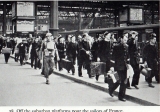
French sailors at Waterloo station.

A member of the Auxiliary Military Pioneer Corps, a veteran of WW1, is helped ashore at Dover.

A young girl passes a bag of sweets or cigarettes to a British soldier at Wandsworth Road station.
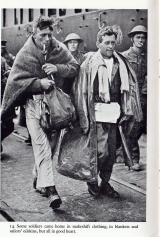
Soldiers of the BEF at Dover Western Docks railway station.
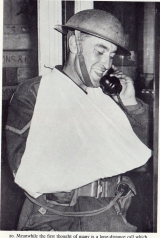
A Lance-Corporal of the BEF telephones home from Ramsgate station.
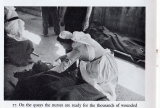
Nurses attend the wounded on the quayside at Dover.
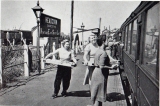
Trays of sandwiches and cakes are distributed at Headcorn one of the feeding stations.

A fully laden Royal Navy destroyer berths at Dover.
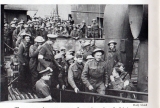
BEF troops disembark from a destroyer at Dover.
